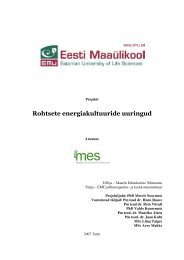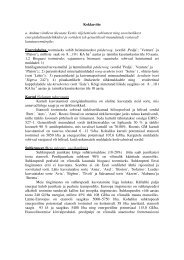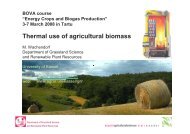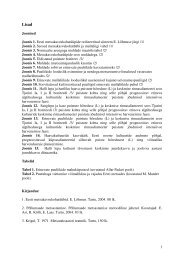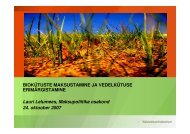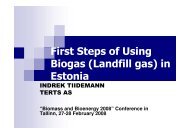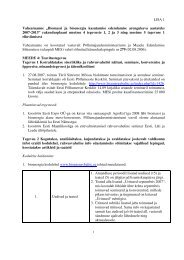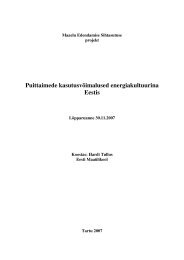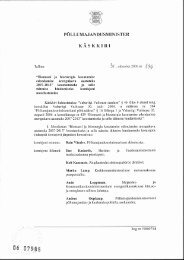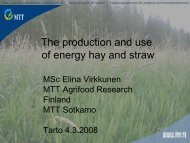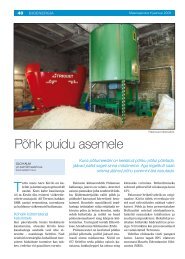Põllumajandusministeeriumi ja Maaelu ... - bioenergybaltic
Põllumajandusministeeriumi ja Maaelu ... - bioenergybaltic
Põllumajandusministeeriumi ja Maaelu ... - bioenergybaltic
Create successful ePaper yourself
Turn your PDF publications into a flip-book with our unique Google optimized e-Paper software.
When growing biomass on large areas, a grass harvesting conveyer should be formed<br />
with the species of the different speed of development. When calculating the area of sowing,<br />
we should proceed from the time of harvesting of a single species field which must not be<br />
longer than five days. The amount of biogas received from biomass digestion is closely<br />
connected with the phase of development of the herbage plants and it decreases when the<br />
herbage ages and this is why late mowing decreases the productivity of biogas. The list of<br />
recommended species in the order of the speed of development in spring, starting from the<br />
quickest one, is the following: cocksfoot grass, reed canary grass, smooth bromegrass, tall<br />
fescue, timothy. In making the conveyer we should bear in mind that the speed of<br />
development of reed canary grass, brome grass and tall fescue is rather similar and this is why<br />
the difference in the optimal harvesting time is only a couple of times.<br />
Field Crops Production of bioenergy from field crops<br />
Corn (Zea mays L. ssp.) is the most widely spread culture for producing biogas in<br />
Europe. From corn a big amount of biomass is received per hectar and it is ensilaged well.<br />
Most evidently corn is one of the best cultures of biogas for us.<br />
Potato (Solanum tuberosum) as a culture rich in starch can be used both for producing<br />
bioethanol and biogas. In Estonian conditions the area of growing potatoes is decreasing each<br />
year and in 2007 it was only 10,200 ha. This is why to grow potatoes for producing ethanol is<br />
not reasonable. Potato growing is connected with a rather big use of energy and because of<br />
that energy output is modest 0.8 – 1.6. When it is decided to produce bioethanol from potatoes<br />
the high yield and rich in starch cultivars, or specially bred industrial GMO cultivars, must be<br />
selected for growing in local conditions. In Estonia, there is no starch production resulting in<br />
big amounts of wastes. Growing potatoes as an energy culture, all the agrotechnological<br />
methods should be applied- correct soil tilling, fertilization with both organic and mineral<br />
fertilizers, early planting, timely plant protection, even watering. When using all these<br />
requirements, it is possible to receive big yields of tubers rich in starch.<br />
Sugar beet (Beta vulgaris saccharifera) is an important energy culture both globally<br />
and in the whole of Europe. In Estonian conditions growing sugar beet is minimal, connected<br />
with a big energy and human labour need. This is why the Estonian list of cultivars does not<br />
contain a single cultivar. For growing sugar beet as an energy culture, such cultivars which are<br />
grown by our close neighbours Latvia and Lithuania should be recommended. Annually sugar<br />
beet gives 240 GJ/ha of energy, out of which 45% or 108 GJ/ha can be made into ethanol. The<br />
energy potential of the local sugar beet in producing ethanol is on average 58 t/ha of beets, the<br />
yield of ethanol 93 l/t and 5400 l/ha and the amount of energy 115.0 GJ/ha. Up to 90% sugars<br />
of the beet can fermented into ethanol. From the tops of the beet and the side product of<br />
ethanol production it is possible to produce valuable biogas. One kilogramme of dry matter<br />
may give 230-400 l of biogas. In energy beet N, Na and K are important influencing sugar<br />
extraction.<br />
Rape (Brassica napus) and biennial turnip rape (Brassica rapa oleifera) are also the<br />
major field crops in Estonia which can be used for producing high quality biodiesel fuel. From<br />
the point of view of energy management, the production of biodiesel fuel from rape seeds is<br />
useful. When taking into consideration all the energy costs connected with production, it is<br />
possible to produce 1.3-1.6 times more energy from a hectare. The production can be used<br />
both as food and a source of energy. By 2007, the area of growing rape and biennial turnip<br />
rape is already 72,500 hectares. Later there may be problems with the fields of growing<br />
31




